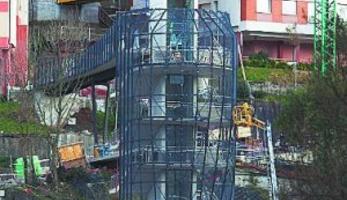Vertical transport
Basic Information
Mobility solution ID
57
Timeline
- complete
Project
Summary
The hilly topography of Donostia-San Sebastian can be a significant barrier for people to cycle or walk to the city centre. As half of the inhabitants live in these hilly parts of the city, the municipality introduced a vertical transport solution to make trips for cyclists and pedestrians easier and more convenient.
Implementing sustainable mobility
The goal of Donostia-San Sebastian for this measure was to increase the offer of vertical transport facilities with five new elevators and one new escalator. The main objective was to:
- increase the number of pedestrians and cyclists in the city.
Progress
In October 2009, Donostia-San Sebastian conducted an evaluation of existing public vertical transport systems such as lifts, escalators, funiculars and cycle lifts. The study provided criteria for assessing the merit of such systems in different districts and led to a final selection of locations.
The first new lift became operational in February 2010 and construction works continued until 2011. The new vertical transport systems realized during the CIVITAS project were:
- A lift at Rutilita (7 meters)
- Two lifts covering a height of 40 metres (25+15) in the district of Aitzgorri-Avanco
- A lift with a height of 18 metres in the area of Aldunaene.
- 2 lifts at Buenavista covering 23 meters of height
- A lift covering 20 meters of height difference in Azkuene-Gomistegi
- An escalator with five different ramps in the Lizardi street (27 meters of height difference)
The lifts were included in the map of pedestrian and cycling routes that was produced to promote walking in the city. The map points out that the vertical transport systems can create new walking routes and alleviate existing ones.
Outcomes
Vertical transport are recognized by the majority of the population. A huge majority of the population (98% in 2011) approved the system (ranked the system with a score of 5 or higher), providing it with an average rate of 8,9 out of 10. It was mostly agreed that vertical transport increases the accessibility of hilly neighbourhoods and contribute to increase non-motorized mobility, also increasing the attractiveness of the neighbourhood.
This wide acceptance of the system was followed by significant usage levels, reaching 4.879 daily users in 2012 (2.801 in 2011 when only part of the network was in operation). An overall analysis of the data revealed that vertical transport is more used when located in highly populated neighbourhoods connecting hilly areas with important commercial areas and/or public transport nodes.
The extension of the vertical transport network contributed to a steady increase in the use of non-motorized modesin the city. Although difficult to isolate the impact of this sole measure, which is estimated to be moderate, the CIVITAS project has achieved an overall reduction in car use of 0,1% as compared with the before situation. It should be highlighted that this achievement is made in a context of a steady increase in car travel, thus it can be considered a positive result.
But lifts, ramps and escalators are very expensive infrastructures. The assessment conducted revealed that implementation and maintenance costs are much bigger for ramps and escalators than for lifts. For example, in Larratxo, the construction of the escalators was twice the cost of the construction of two lifts. While the maintenance cost of the three escalators is about 5 times the maintenance cost of the two lifts. It could be inferred that lifts are the preferred solution based on economic viability. But the topographic characteristics and the number of users can make it necessary to build ramps or escalators (like in the case of Lizardi). Ramps are best indicated for high density connections and main transport nodes (for example train stations). In some areas the topography makes it impossible to build lifts, therefore ramps or escalators are needed.









